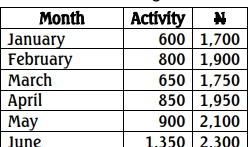- 8 Marks
MI – Nov 2020 – L1 – SB – Q4a – Costing Techniques
Identify the purposes of standard costing systems and the types of standards used in management information.
Find Related Questions by Tags, levels, etc.
- Tags: Budgeting, Cost Control, Standard Costing, Types of Standards
- Level: Level 1
- Topic: Costing Techniques
- Series: NOV 2020
Report an error


